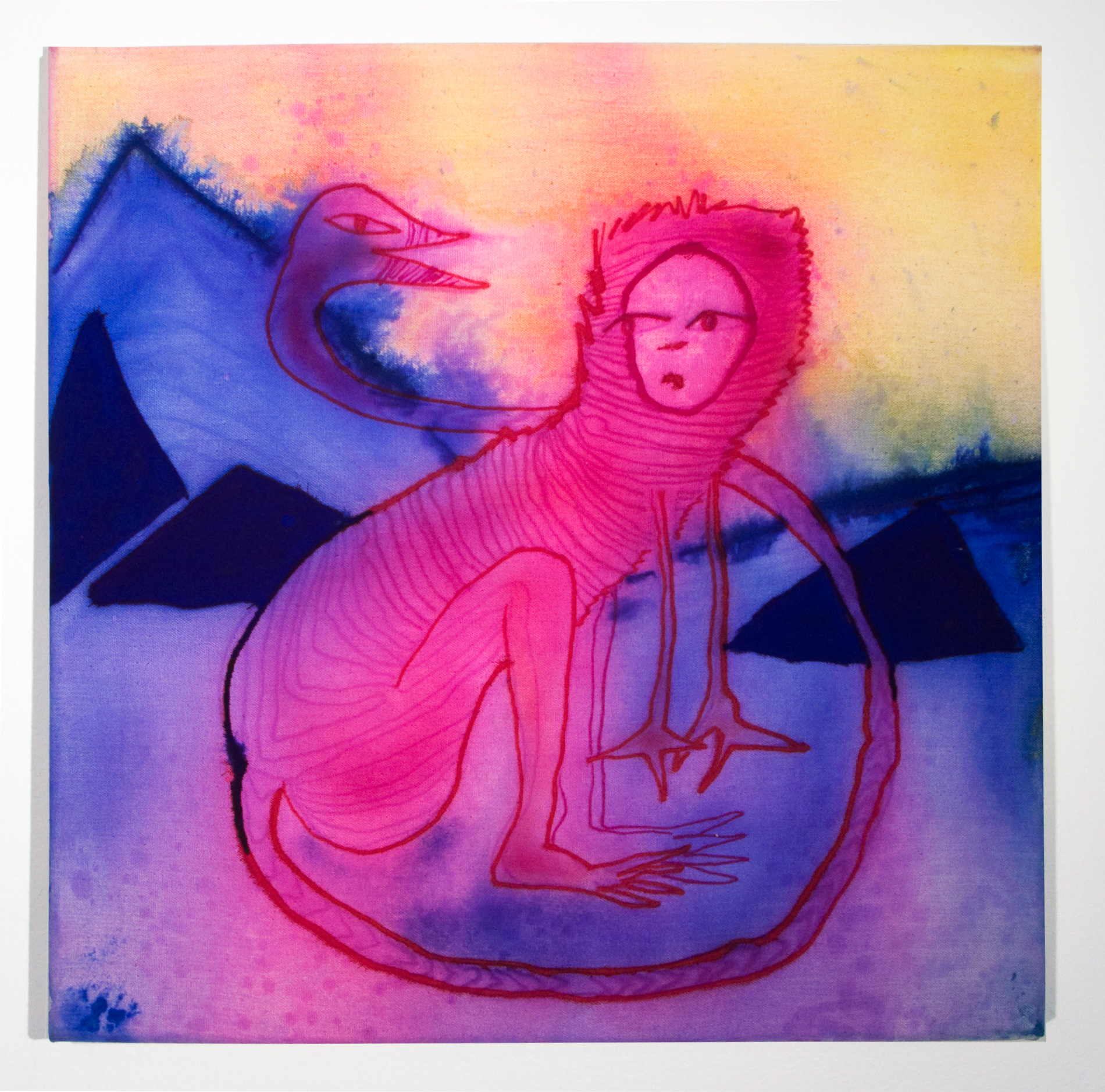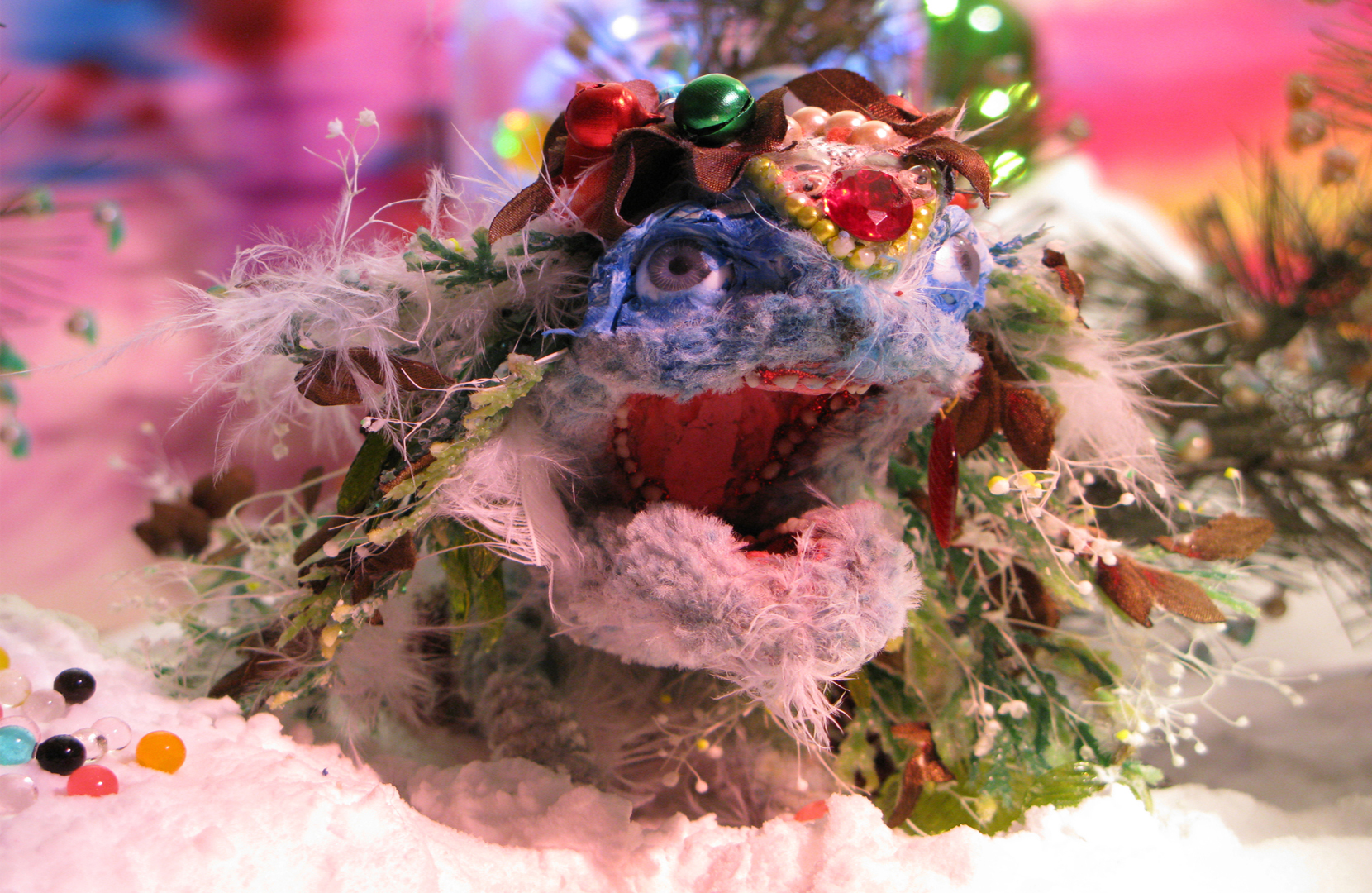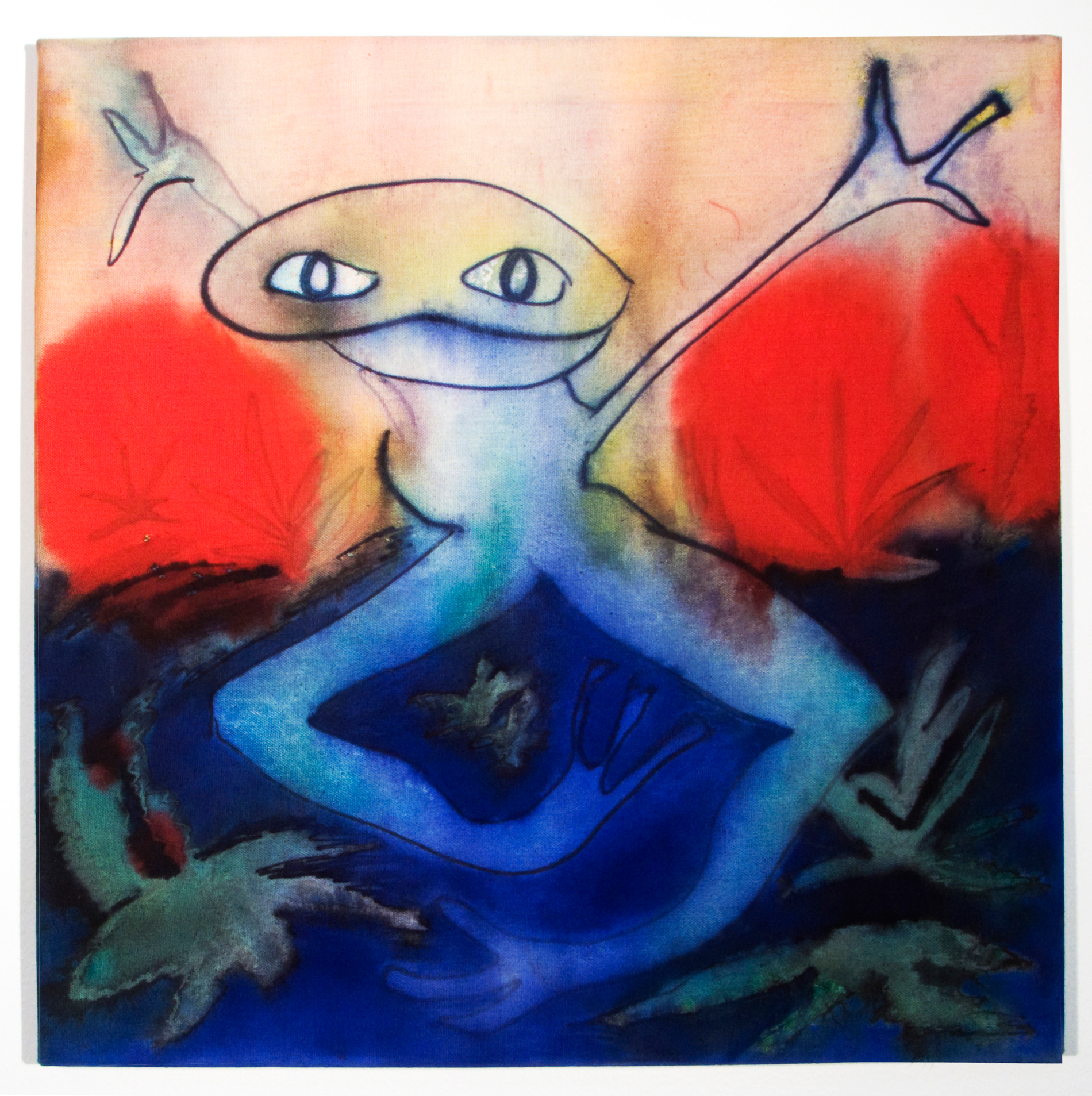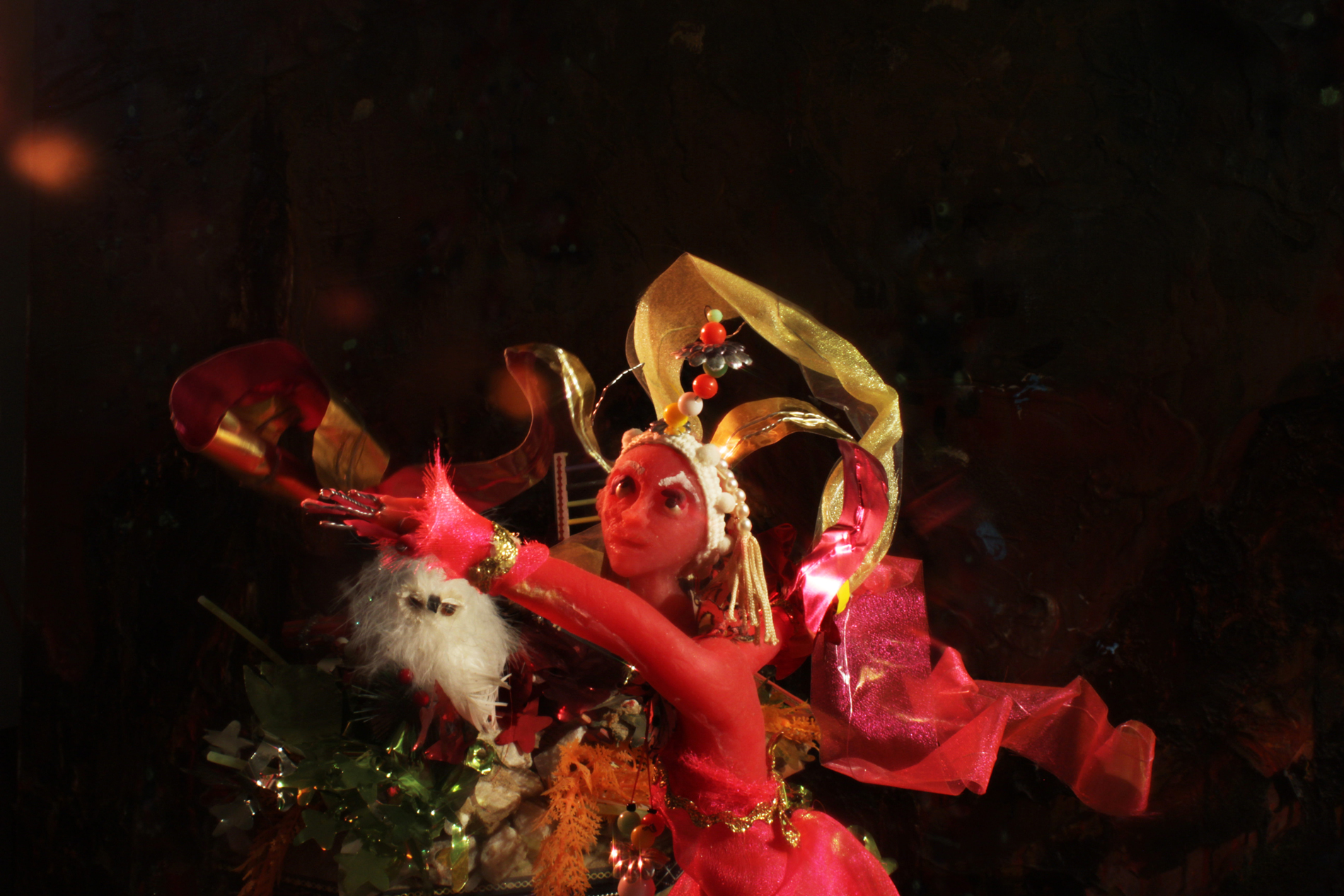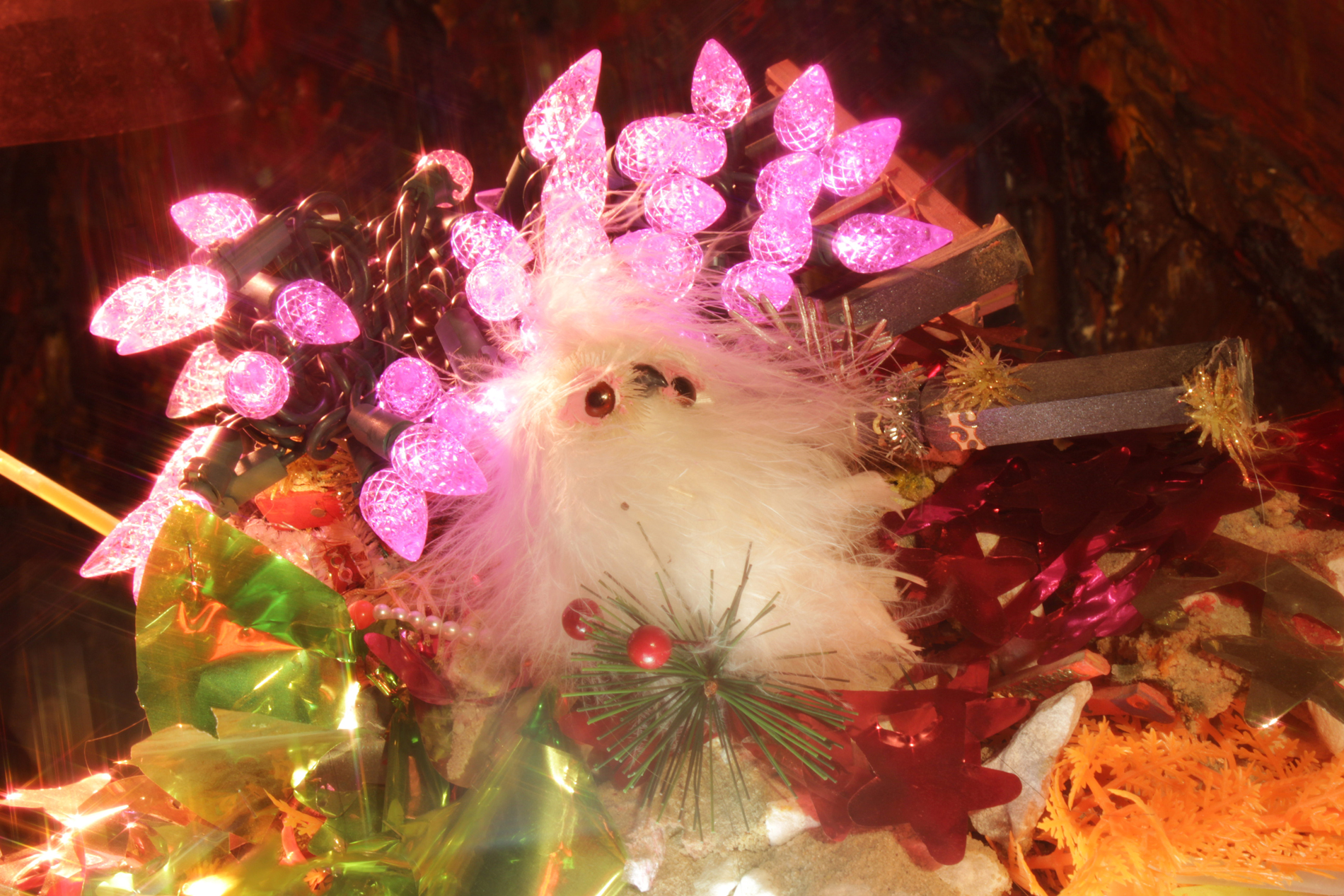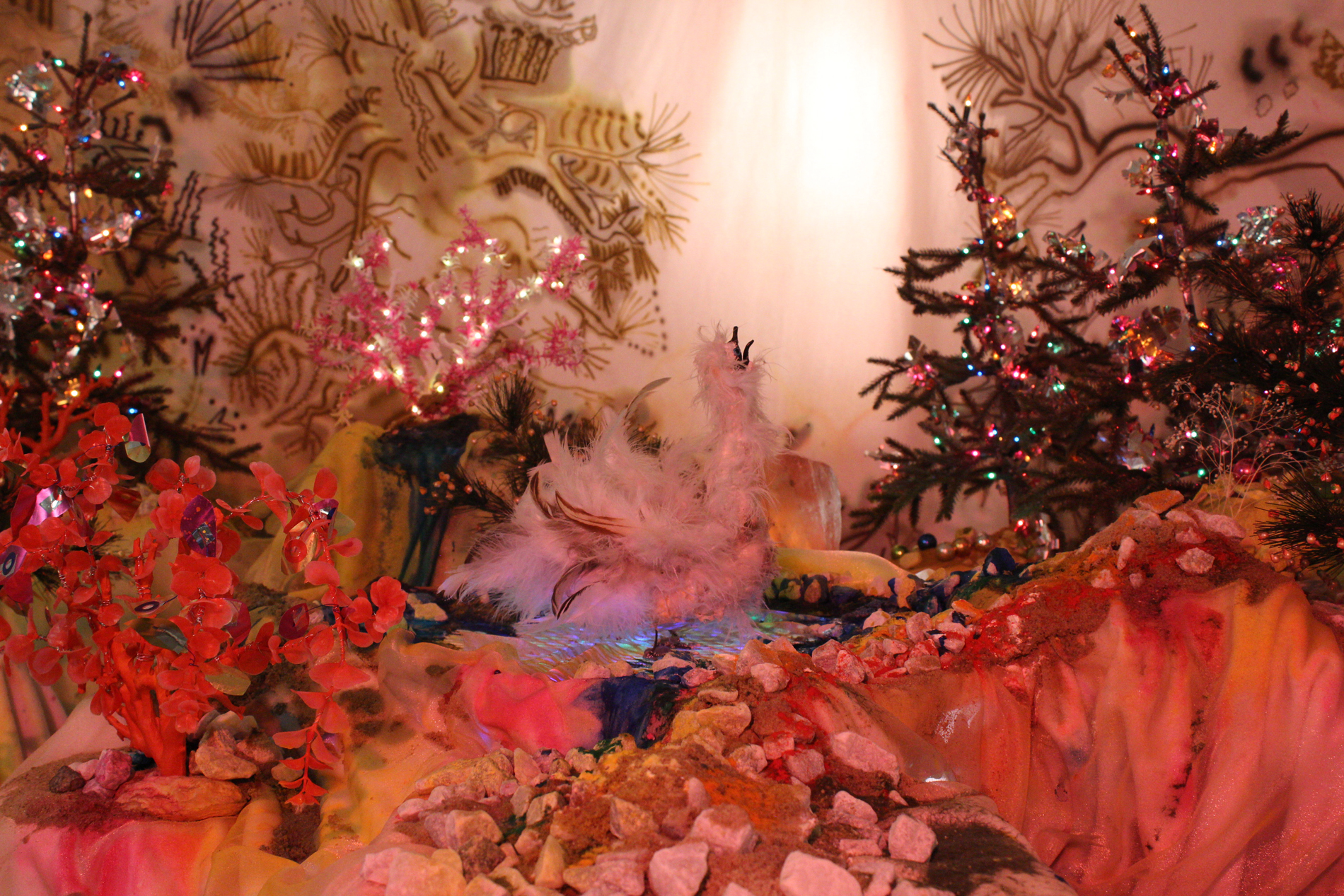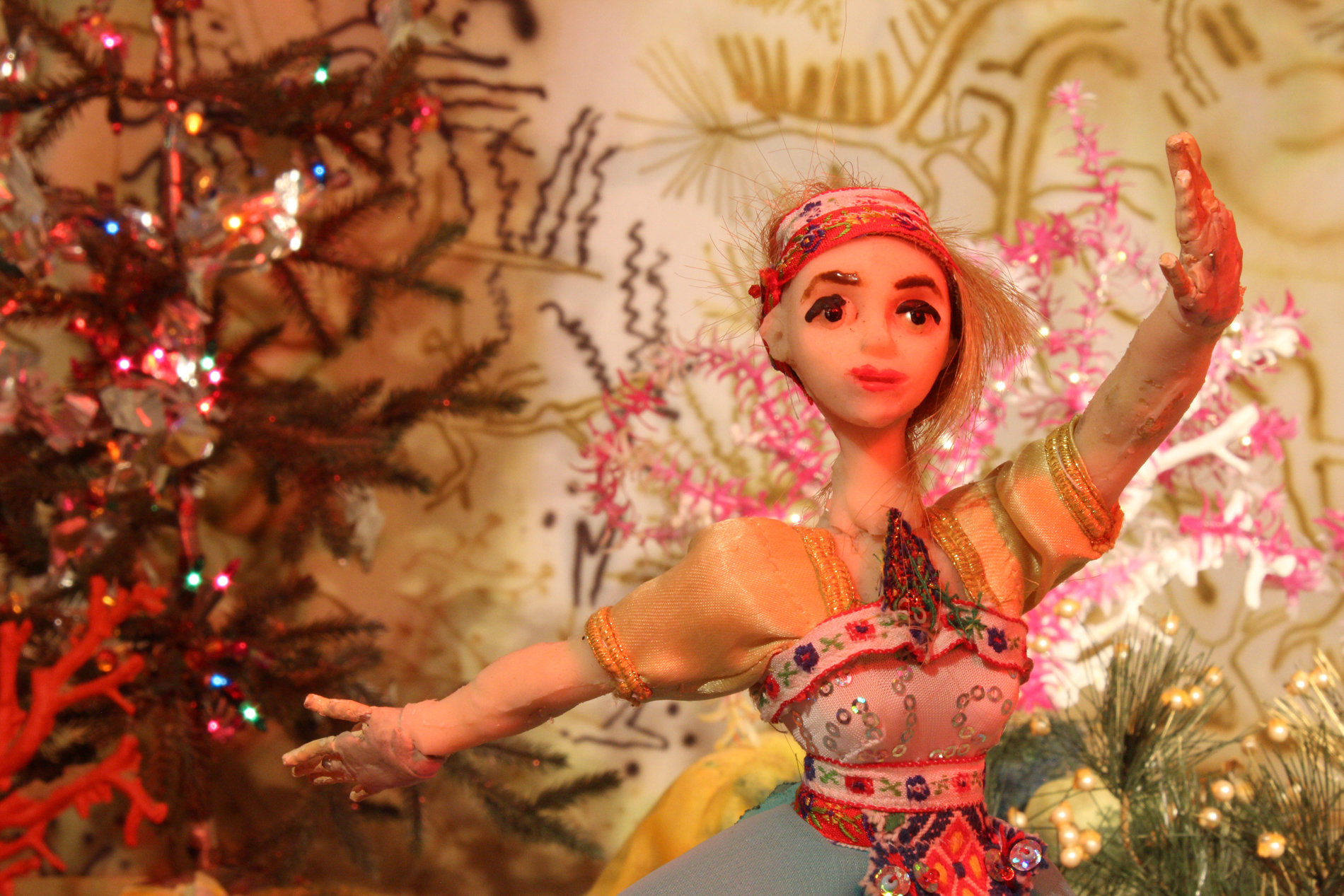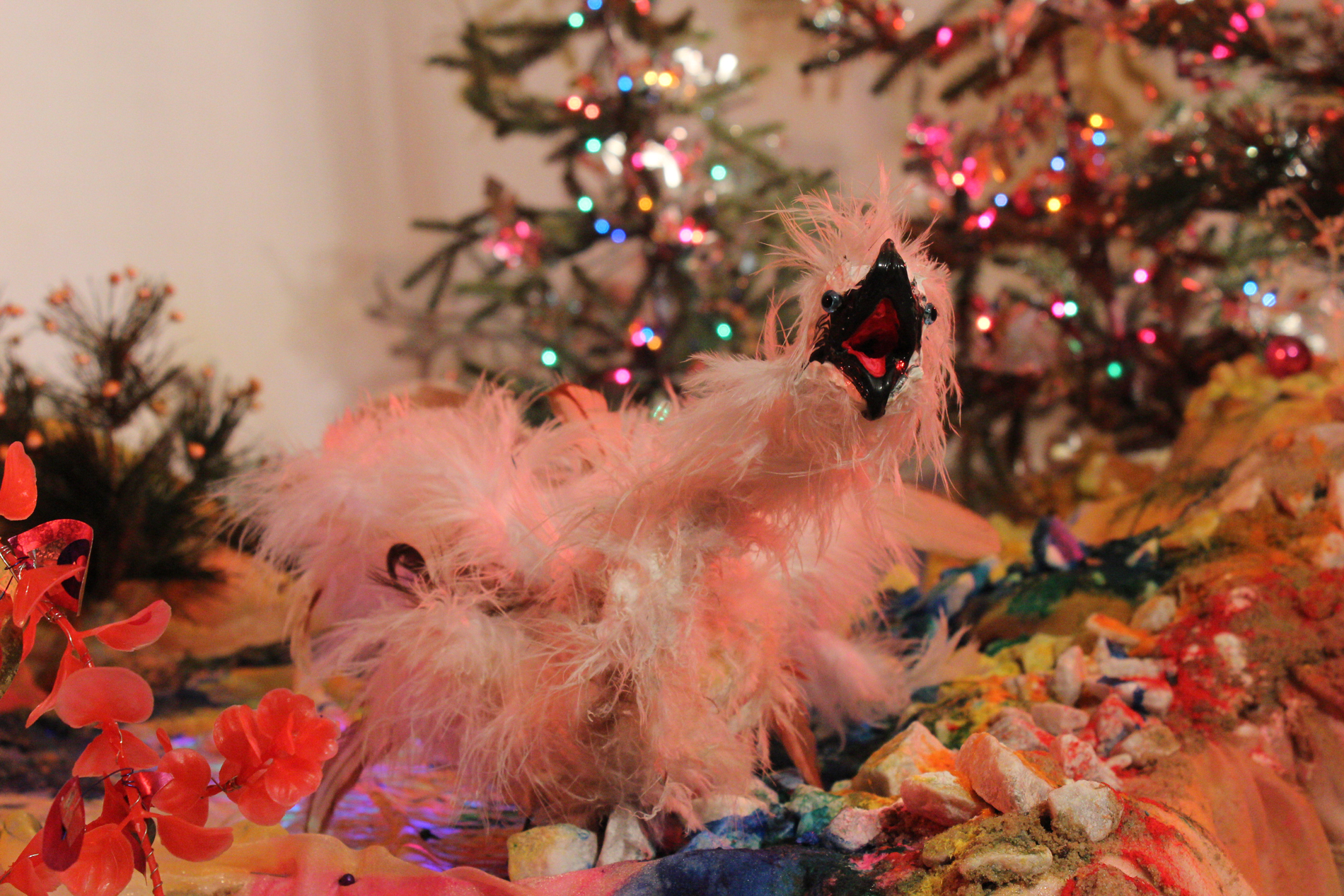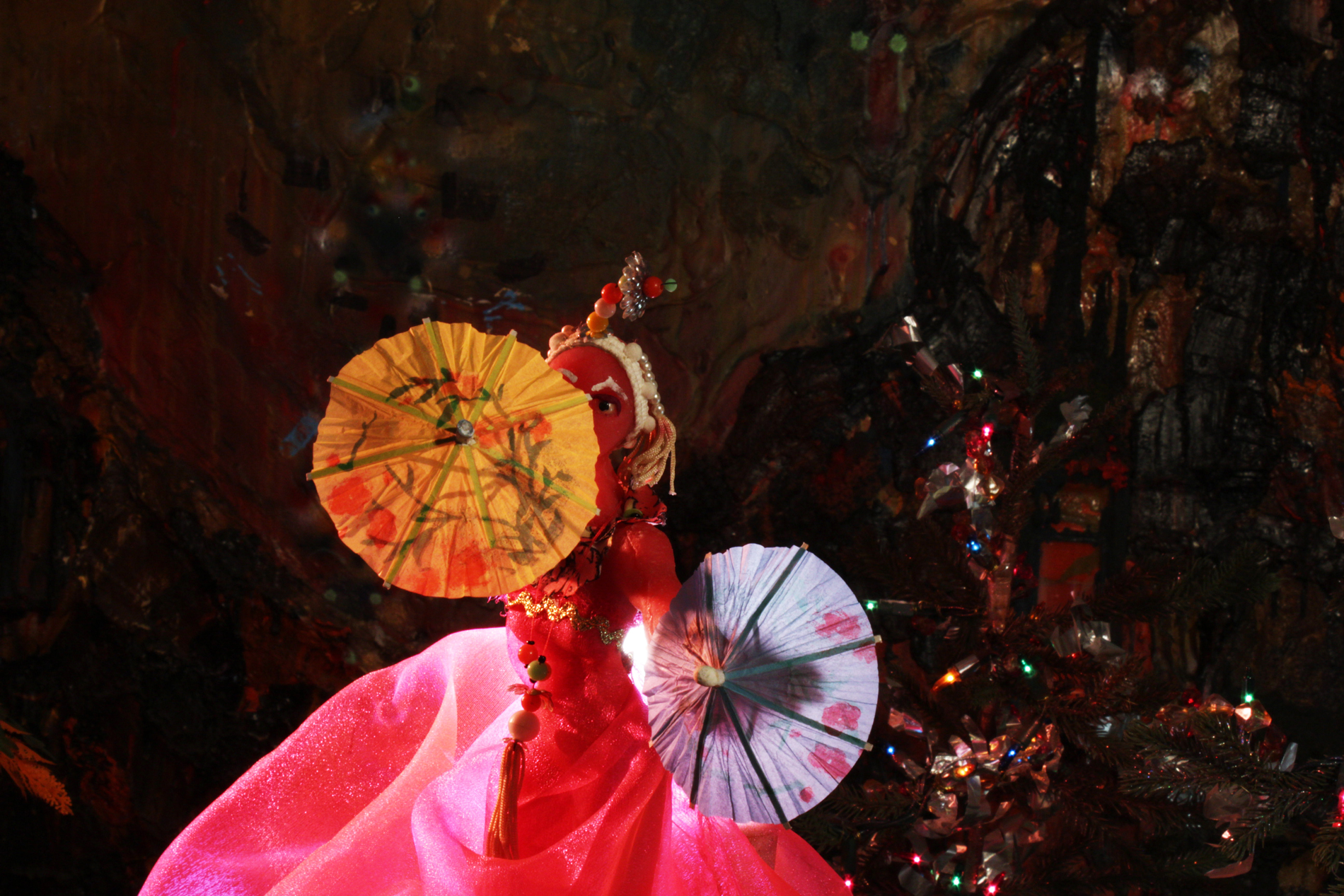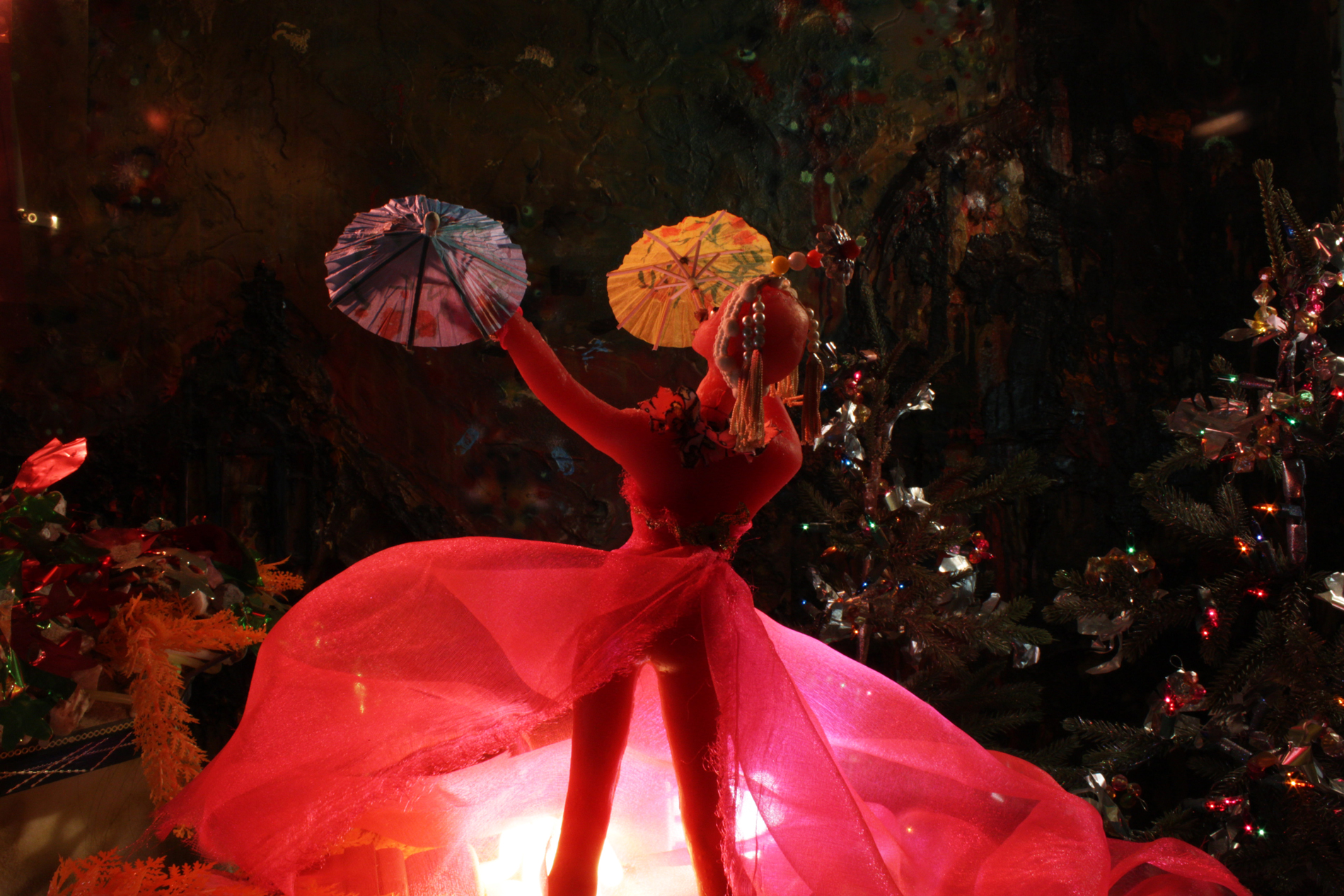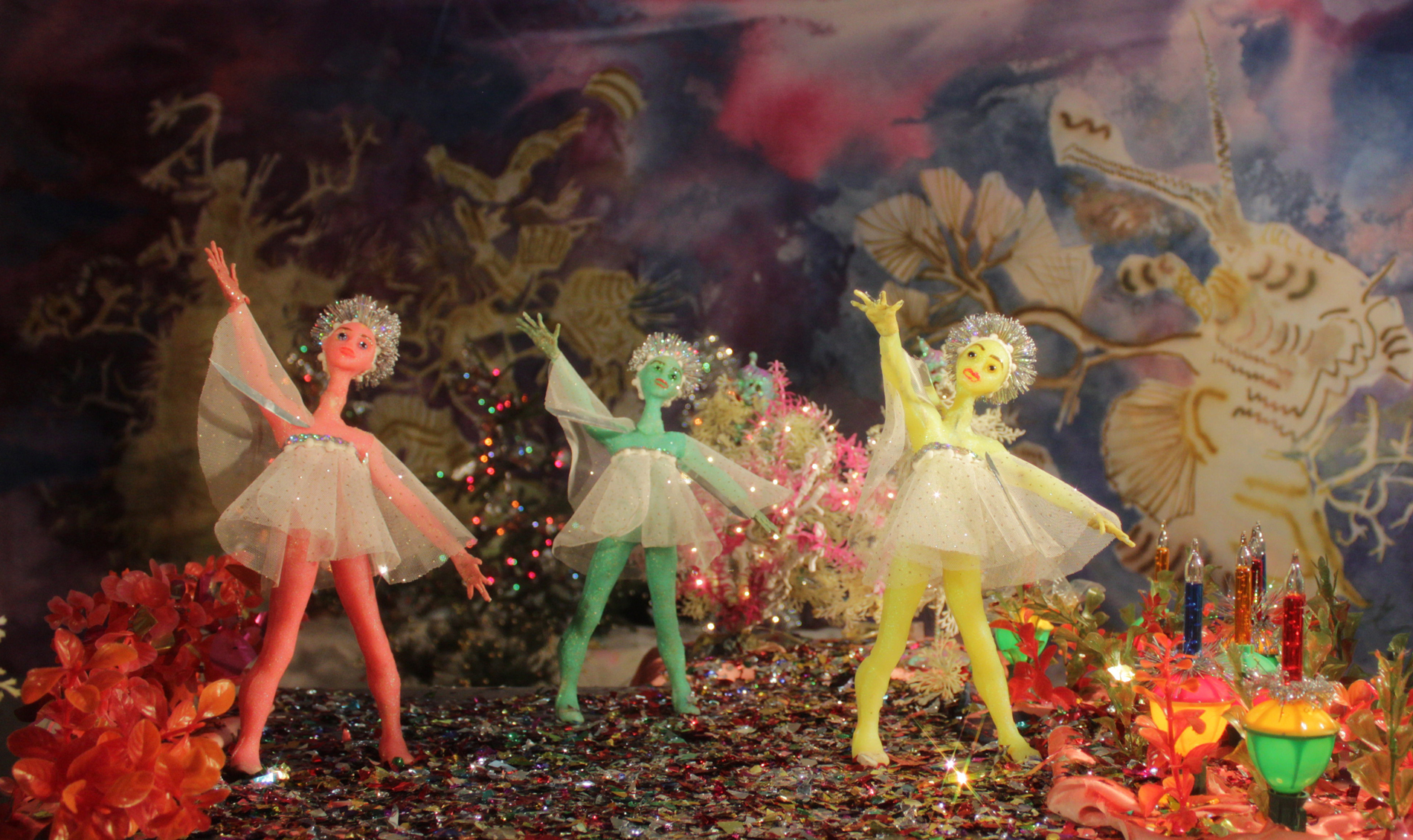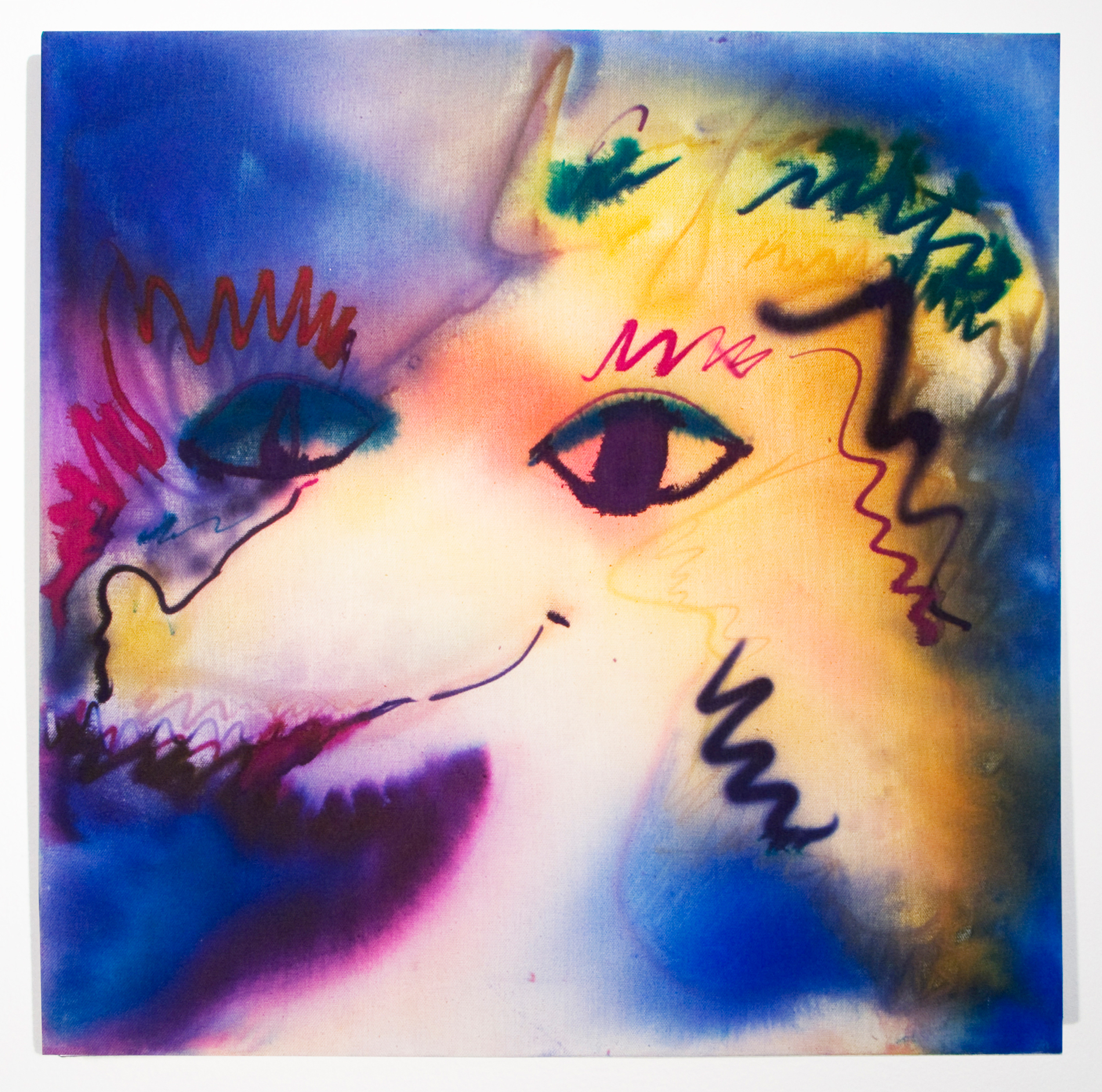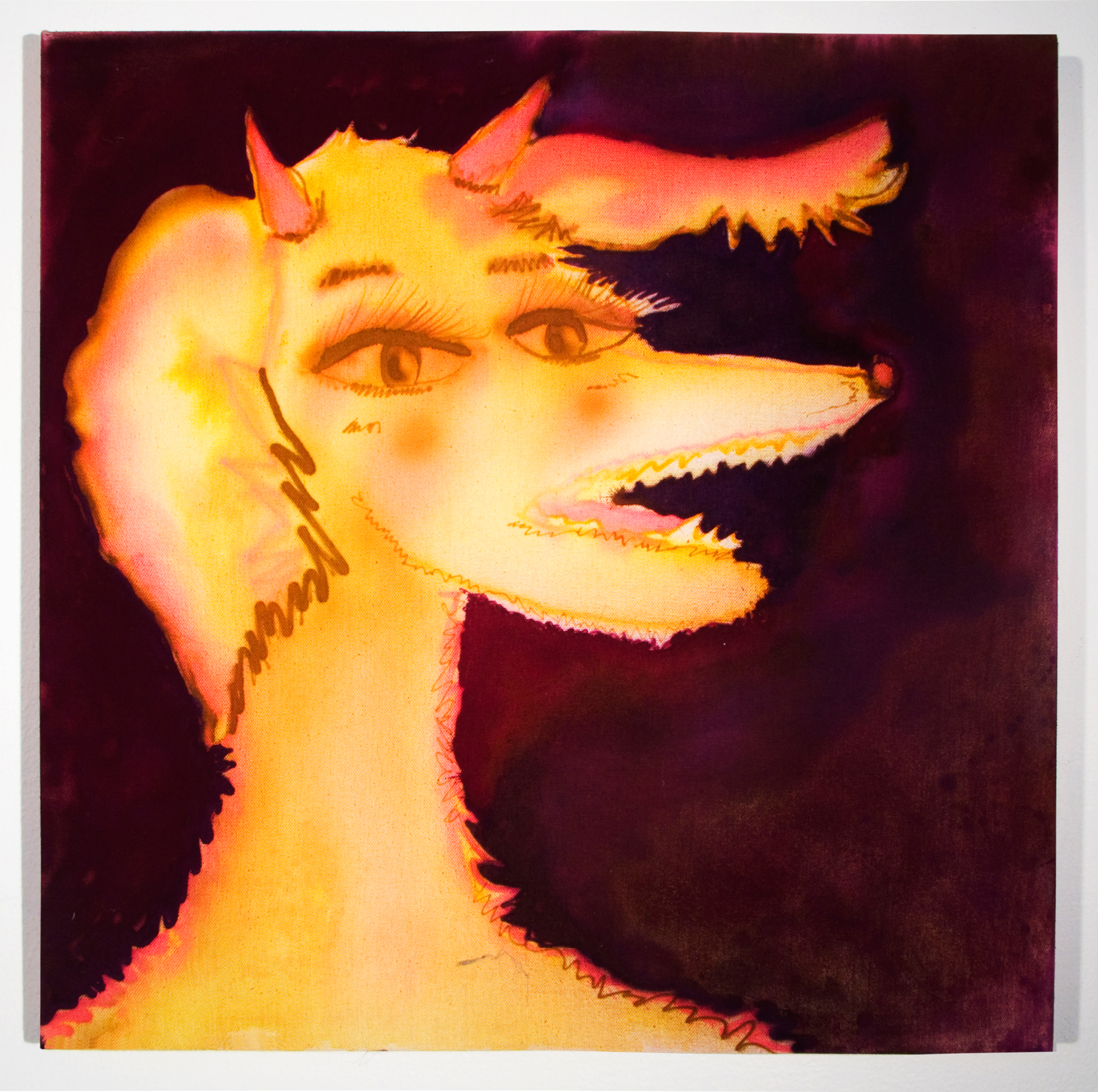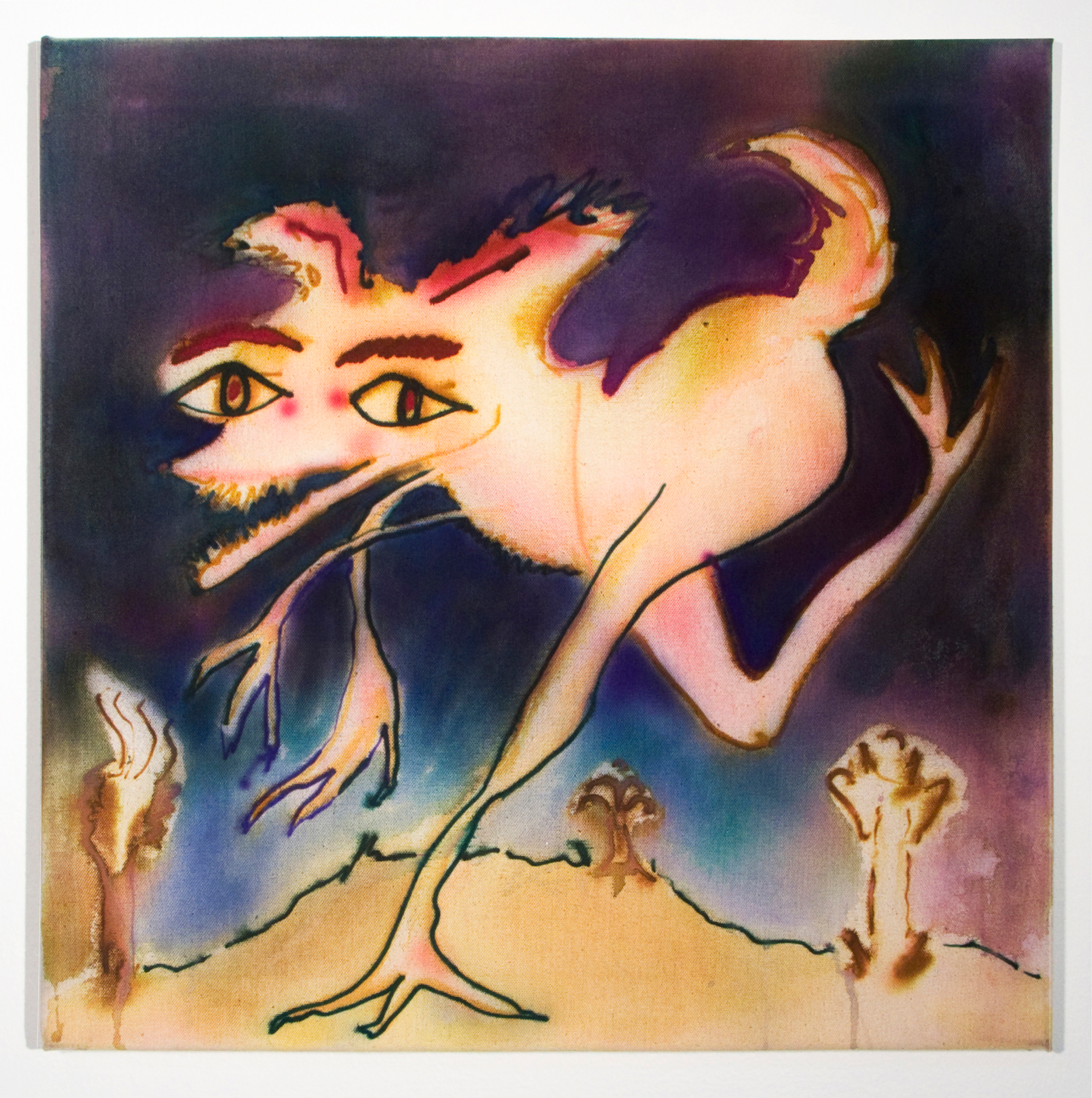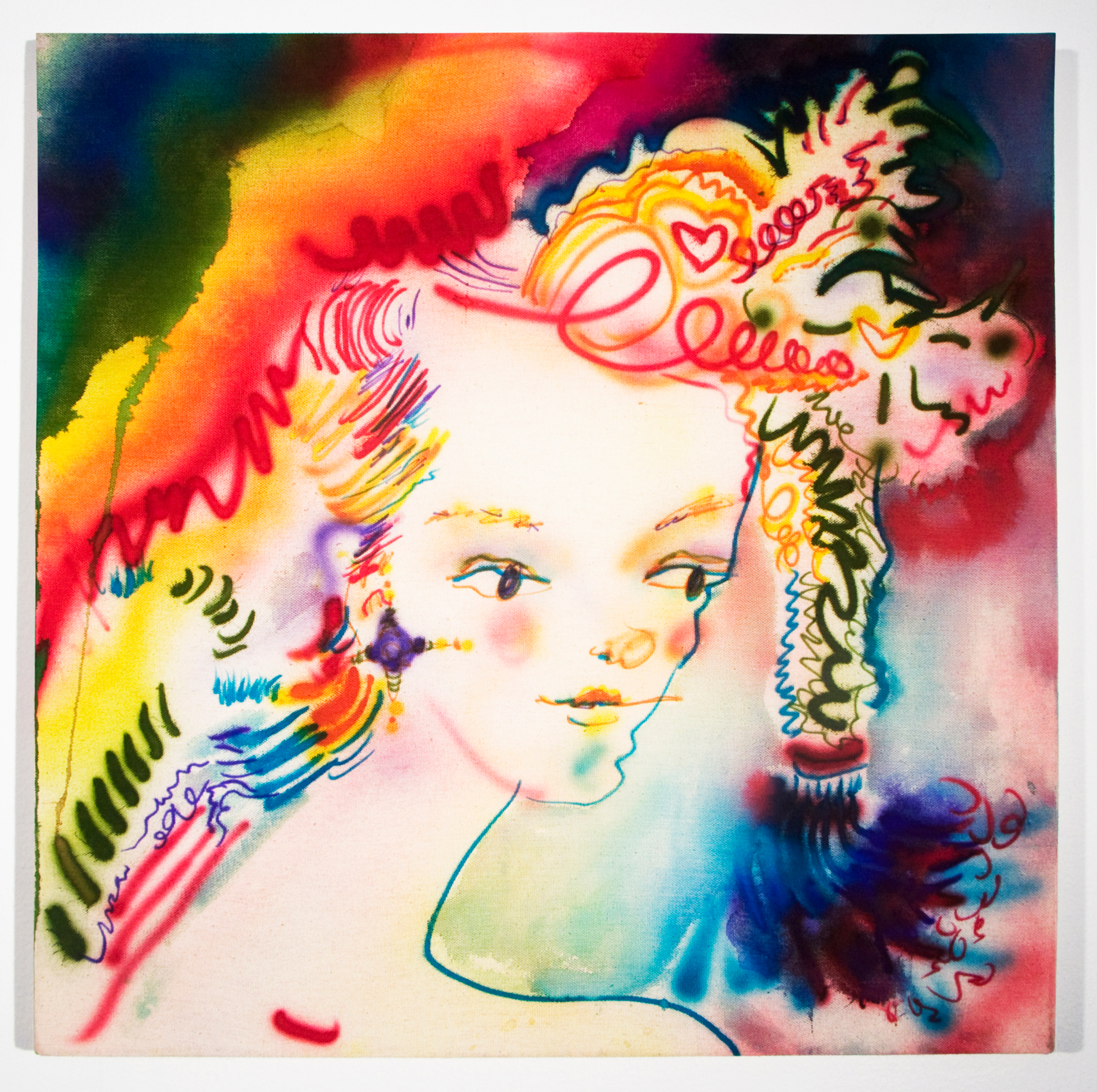This essay was written in conjunction with Erin Dunn: Oceanic Dancer, on view at CUE June 4 – July 9, 2016.
Erin Dunn grew up at the Jersey Shore and spent her childhood exploring the Pine Barrens—the vast patch of forest known for misshapen trees and mythic tales. This odd, unexplored expanse of land in the middle of a region known for its turnpikes and boardwalks, deeply influences Dunn’s airbrushed paintings and stop-motion animations, in which the natural mixes with the grotesque to create mythic illusions.
The Pine Barrens are subtly included in Dunn’s latest stop-motion animation, Oceanic Dancer, with a background of artificial pine trees. The set includes strings of colorful lights, faux flowers, and mounds of sand, representing the contradictory visual worlds of her girlhood. The puppets that she animates in this setting capture the fantasy of performance—the ideal of the dancer who can let go of her inhibitions and allow her body to lead. Inspired by the idea of Freud’s “oceanic feeling”—the concept in which an infant experiences a oneness with the world before it learns that other people inhabit it—Dunn seeks to express that feeling through motion.
A captivating and upbeat tempo anchors the work, which is enhanced by dramatic lightning. It begins with a strange pink bird “dancing” on the whimsical stage—its feathers blowing with each twirl. Dunn makes all her characters by hand, her puppets resembling plastic dolls or, in the bird’s case, a feathered muppet. Oceanic Dancer features female dancers outfitted in eclectic embroidered tops or beaded headpieces, each performing alone on the colorful stage moving between pliés and pirouettes. One dancer, her skin a vibrant red, even dances with paper umbrellas in hand, amplifying the theatrics of the performance. Close-ups of their faces reveal Dunn’s attention to detail—the puppet’s eyes opening and closing during particularly expressive moments. Through a wave or a song, Oceanic Dancer visualizes the freedom of letting go as also a kind of purity.
While Oceanic Dancer was not yet finished when this essay was written, there is little doubt that the momentum created between dance, lightning, and sound will continue to amplify until completed. Judging from previous works, particularly her 2012 stop-motion animation, Rapture’s Adagio, she will build up the complexity of these elements to create unpredictable and elaborate expressions full of mesmerizing movement.
Classically trained in ballet, Dunn’s stop-motion animations are imbued with her sensibility as a dancer. She understands the subtleties of movement—the gesture of the hands or the point of a toe—adding a sophisticated elegance to the aesthetic of her work. She subverts this elegance, however, with grotesque imagery out of old-time fairytales. Also referencing surrealist film and painting, she embraces odd, distorted shapes and densely filled spaces, layering elements on top of one another to create elaborate sets and eccentric characters. Dunn’s works also have a deliberate “girlishness” to them—the artist unafraid of the stereotypical pinks and purples, or even glitter and sequins, often associated with female adolescence. Dunn’s work is thus a complex aesthetic of contradictions. It is at once elegant and kitschy, natural and artificial. Her works are full of illusion and fantasy, but yet feel relatable and familiar.
While Dunn’s work is certainly in dialogue with a number of contemporary artists who embrace stop-motion animation and the fantasy of its methodology, such as Allison Schulnik and Nathalie Djurberg, her practice more importantly harks back to earlier animators. Stop-motion animation from Eastern Europe, such as Czech artist Jiří Trnka and his studio, had a clear influence on Dunn’s artistic development. Beginning his career as a set designer, Trnka, like Dunn, came to animation through the stage, merging the tradition of Czech puppet theater with film and maintaining a commitment to the handmade. As an illustrator for the Brothers Grimm, Trnka also took inspiration from myths and children’s tales in which stories about love and friendship were full of strange and frightening details.
For Dunn, this reference to childhood stories is important. Citing her interest in myths and fairytales from around the world, she intentionally celebrates the fantasies of youth while also reminding us that these stories are very often dark, their meanings imbedded in the complexities of life. Indeed, as much as Oceanic Dancer speaks to the freedom of letting go, it is also full of nostalgia, particularly the nostalgia for the carefree ethos of adolescence. The work also speaks to desire and the act of looking at the female body. In this way, the sexualized environment of growing up as a young dancer, where the body is constantly on display, makes its way into the work, with Dunn inviting viewers to ask: Are they dancing for themselves, as if alone in their bedroom, and, if not, who are they dancing for?
Painting and drawing are also central to Dunn’s practice. In her latest series of watercolors, she airbrushes canvases to create brightly colored portraits of female characters or made-up creatures, some anthropomorphic, others recognizably animals. Though she often exhibits these works separately, the relationship between her painted characters and sculptural puppets is evident, their odd-shaped bodies and exaggerated, black-lined eyes evoking the same mythical presence. The semi-translucent airbrush aesthetic—referencing the caricaturists and material kitsch of the Jersey Shore’s boardwalk—also heightens the sense of fantasy in her work.
Furthermore, Dunn frequently incorporates painted elements in her animations. Rapture’s Adagio, inspired by Piero Camporesi’s essay “The Prodigious Manna,” begins with stunning hypnotic abstractions overlaid with filmed sequences of beaches and forest. The abstractions evoke the hallucinatory visions of the main character, Santa Chiara da Montefalco, a medieval nun whose heart, the story goes, was pierced by the cross, giving her lifelong hallucinations and pain. These abstractions first appear as circular dots of varying colors floating in the center of the work, animated to resemble fireworks or kaleidoscope patterns that appear and disappear as the film progresses. Like her puppets, Dunn’s painted abstractions move and change with the rhythm of the work, at first mimicking the slow, methodical tempo of a haunting male voice, later simulating the tonal pulse of a heartbeat, offering a new, animated take on optical illusion.
The eleven-minute stop-motion animation leads us through moments in Sister Chiara’s life as a nun, the abstract animations becoming the background to a more formal set for Dunn’s puppets’ performance. From engaging in ritual acts to dissecting a human heart, movement—including an impressive synchronized duet—remains at the core of the animation. From animated illusion to concrete reality, the work culminates with Sister Chiara, the hallucinations and chest pains gone, dancing naked on an actual beach, her long dark hair cascading down her back—representing, once again, the freedom of letting go. Both Rapture’s Adagio and Oceanic Dancer underscore the deep sense of spirituality that runs through Dunn’s animations. Whether pulling from the performativity of Catholic rituals or reminding us that dance can be a spiritual exercise, Dunn is interested in showing how the body is central to systems of belief.
Following in Trnka’s tradition, Dunn imbues her training as an animator with her sensibility as a craftswoman. Producing nearly all of the components that make up her animations, from painted backdrops and costumes, to lightning and sound, Dunn enjoys the process of making—the hot glue gun just as important as the camera. She is committed to knitting and sewing as much as she is to painting and animation and actively engages with new techniques and processes. For instance, for Oceanic Dancer she used YouTube tutorials to teach herself how to make anatomically correct dolls from silicone molds. Embracing the laboriousness of art, Dunn’s process emphasizes the time and energy involved in the production of stop-motion animations.
In this way, Dunn continuously blurs reality and illusion. She explains, “I am tricking the audience to enter a world, when really it is just sand on my table.” Indeed, throughout her work, she invites us to consider the contemporary place of fantasy, asking what is reality and what is illusion? As we know with stop-motion animation, what appears to be a dancer seamlessly moving through space is merely a puppet posed in each graceful arc or twirl, the real movement coming from the artist herself, invisible to the viewer’s eyes, slowly orchestrating the entire fantasy behind the scenes.
Writer Rachel Heidenry is an art writer and curator based in Philadelphia and New York. She focuses on contemporary art from the United States and Latin America, with particular interest in photography, video, and public art. Heidenry was a 2011-2012 Fulbright Scholar in El Salvador, where she studied post-war mural painting. From 2012-2014, she was the Senior Curatorial and Research Fellow at Slought in Philadelphia. Her writing has appeared in publications including The Architect’s Newspaper, Artblog, Public Art Dialogue, Artsy, and the Pulitzer Center for Crisis Reporting. She holds a B.A. in art history and human rights from Bard College and is currently completing her M.A. in modern and contemporary art history at the Institute of Fine Arts, New York University.
Mentor Amei Wallach is an art critic, commentator, and filmmaker. Her feature-length documentaries include Louise Bourgeois: The Spider, The Mistress and The Tangerine (2008), co-directed with the late Marion Cajori, and Ilya and Emilia Kabakov: Enter Here (2013). Her next film will be 1964: Rauschenberg Wins! She has written or contributed to more than a dozen books. Her articles have appeared in such publications as The New York Times Magazine, The Nation, Smithsonian, Vanity Fair, Art in America, and ArtNews. She was on-air arts commentator for the PBS MacNeil/Lehrer NewsHour and chief art critic for New York Newsday. She was president of AICA-USA between 2000 and 2005, and is founding program director of The Art Writing Workshop, a partnership between AICA-USA and the Creative Capital | Warhol Foundation Arts Writers Grant Program.
This essay was written as part of the Young Art Critic Mentoring Program, a partnership between AICA-USA (US section of International Association of Art Critics) and CUE, which appoints established art critics to serve as mentors for emerging writers. In 2014, CUE joined forces with Art21, combining the Young Art Critic Mentoring Program with the Art21 Magazine Writer-in-Residence initiative. Each writer composes a long-form critical essay on one of CUE’s exhibiting artists for publication in CUE’s exhibition catalogue, which is also published by Art21 in its online magazine. Please visit aicausa.org for more information on AICA-USA, or cueartfoundation.org to learn how to participate in this program. Any quotes are from interviews with the author unless otherwise specified. No part of this essay may be reproduced without prior consent from the author. Lilly Wei is AICA’s Coordinator for the program this season. For additional arts-related writing, please visit on-verge.org.

